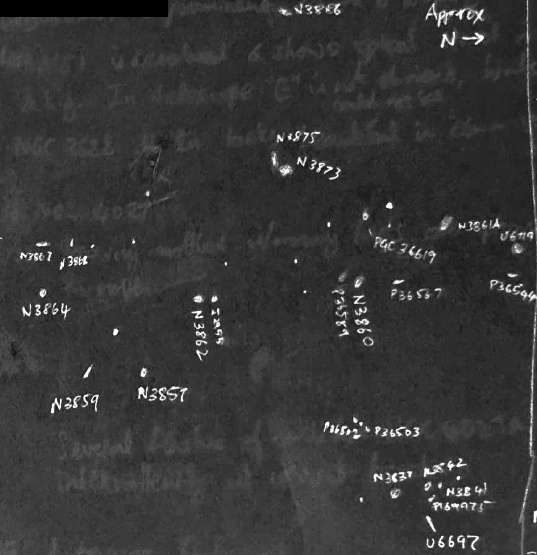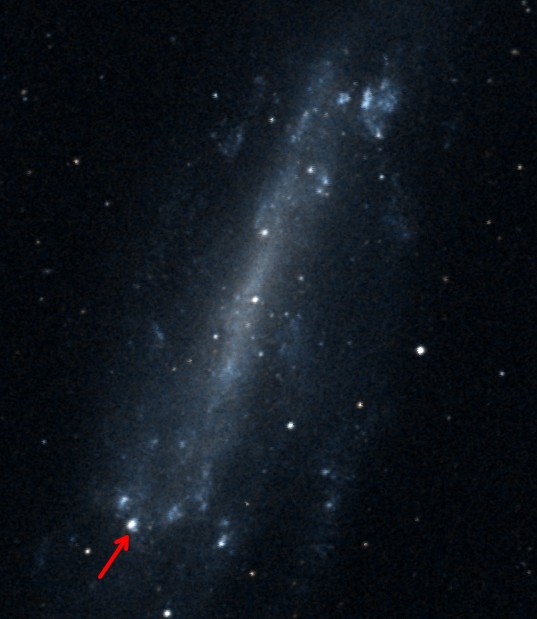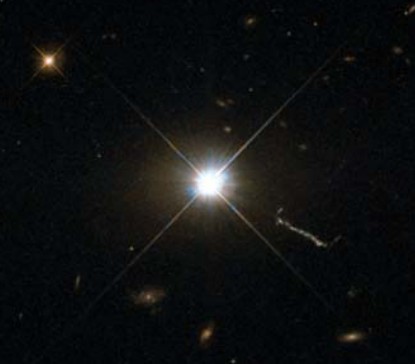This is the third part of my experiences with the RASC Deep-Sky Challenge List, covering objects 19 through 27.
Abell 21 , the Medusa Nebula
This is a nice planetary nebula in Gemini, and it’s unfortunate I’ve looked at it just once, back in Nov 2013. At 80x with an OIII filter, I described it through my 18-inch f/4.5 as an asymmetric, curved region of nebulosity resembling a segment of a circle with a raggedy inner boundary. I must go look at it again.
Jones-Emberson 1 , the Headphone Nebula
The first time I ever heard of or looked at this beautiful planetary nebula was at an observing run with John Tatarchuk, with whom I went observing many times during my early years in Texas and whose 18-inch I came to purchase. I remember my amazement when he pointed his 25” at the object! It basically looked like a over-the-ear headphone! That was back in 2010.
My experience through my 18-inch under the exceptional skies of Texas Star Party 2012 was similar. Using only 67x, my rough sketch shows a headphone shaped nebulosity with a dim completion of the circular structure (the “beard” of the wearer, perhaps?). In 2013 from central Texas, I described it as “dim and rather difficult to see”. I was using 67x and an OIII filter.
I’m surprised that I haven’t visited this planetary that made such a strong impression on me more recently; the only reason for that is there is simply a lot to observe in the universe.
Leo I , the Regulus Dwarf (plus Leo A and Leo II )
This is another RASC Deep-Sky Challenge object that can open an entire can of worms. The Local Group contains numerous dim dwarf galaxies that have been a source of substantial suffering to my observing life. Their challenge is irresistible, yet they only yield (at least to my vision) under the most opportune of conditions. Tiny distant galaxies of magnitude 16+ can at least be tackled by throwing more aperture at them, but low surface brightness is a different monster.
I don’t know of an English text where this is captured as nicely, but the Praxishandbuch Deep Sky by the Vereinigung der Sternfreunde explains very well that the surface brightness of an object can only be decreased by a telescope, never increased. The best we can do (and they cite Mel Bartels) is to use maximum exit pupil, i.e. about 7mm, and magnify an object without reducing its surface brightness. To this end, Mel Bartels even recommends changing telescopes instead of changing eyepieces—or at least that’s how I understood it. Therefore, contrast, clarity and transmission of optics, quality of sky, darkness of sky, low humidity, low airglow—all these factors become more important than aperture. I would expect that a well-baffled high-quality refractor of 5-inches might beat a typical 30-inch dob on such targets. I want to say the young have an advantage here, but some of my friends who are pushing 70 can outperform me in this domain, so experience also plays a substantial role.
Leo I is one of the easier local group dwarf galaxies. The others that come to mind that are not in the NGC/IC and are of similar difficulty are perhaps
An easy way to “confirm” that you’re seeing the dim, oval-shaped glow is to not know in which direction from Regulus to look and try all directions in a search for a weak brightening of the background. Do you sense the background a tad brighter in the same area again and again? Maybe you’re on it.
One of my most memorable views of the object was on a poor night at Death Valley National Park. There were plenty of clouds and suckerholes between them. It appears from my logs that the transparency in the suckerholes wasn’t very great either. The sky background was however very dark and the winter milky way was thick next to Orion, seen through the suckerholes. The Gegenschein was evident even at 30° altitude. I wrote this as “Bortle 2 but with horrid transparency, lots of stratus and cirrus.”
Using my 25×100 binocular, I managed to catch Leo I. I logged an “extremely feeble brightening that would have been too weak to confirm had I not predicted its exact location without prior knowledge. Just outside the halo of Regulus!” I’m sure this would be a lot easier on a night of better transparency. I went on to say, “flashes into view very occasionally, and appears elongated and larger than the glow of the nearby double star.”
There are two other well-known dwarf galaxies in Leo—Leo II and Leo A. Leo A is by far the easier, in fact my log entry from April 2016 reads “One of the easier dwarf galaxies.” It seemed like the object was not uniform, but rather had a brighter middle. I was not able to nail down its shape or size. The best view was at 103x in my 18-inch f/4.5.
Leo II, I find to be one of those tough nuts. After several failed and one weak attempt, I finally had a definitive detection on a very good night in the Arizona desert. My friend Hemant Hariyani and I had decided to check out and camp at the “Hovatter Road Antenna Site” used by the Saguaro Astronomy Club. There was a noticeable light dome from Phoenix, but the sky quality was very good even though it wasn’t incredibly dark. Looking at Leo II through my 18-inch using a 18mm Baader Classic Ortho (115x), I wrote “Definitely detected as a very weak glow around a faint star, which is stronger than the haze around similar magnitude stars. The visually more prominent part seems to be due west of the star. The glow is barely above the sky background and is easily attributed to poor optics / transparency until carefully inspecting the other stars.”
Steve Gottlieb discusses Leo I and Leo II in his article in the October 2023 issue of Sky & Telescope magazine, and Scott Harrington discusses Leo II and Leo A in the April 2024 issue.
If one wants to dig into this further, the excellent book by Wolfgang Steinicke and Richard Jakiel lists over 3 dozen local group galaxies. The actual list has enlarged in length since then as more dwarfs are discovered. Some of them are invisible on DSS2 images—Segue II anyone? Wikipedia has a long list, enough for a lifetime of misery. I have checked off about a dozen and a half of them at this point.
Abell 1367 (and Copeland's Septet )
Abell 1367, also known as the Leo Cluster, ranks high amongst the Abell clusters that are seen nicely in amateur telescopes. Inspired by both Steve Gottlieb’s article and Albert Highe’s deep dive into this cluster, I decided to spend some time studying this cluster using my 18-inch on a mid-Feb 2023 night at a local observing site.
The site was surprisingly dark, a good Bortle 3 with a strong Gegenschein, despite some haze. The conditions started out good, turned into chasing suckerholes, and were returning to being good by the time I was looking at the cluster. There was a breeze blowing and the associated poor seeing, but this did not impede the joy of exploring this cluster!
During an hour and a half of study, I logged over 2 dozen galaxies in the cluster, most of which were faint schmutzes of light with a smattering of bright galaxies providing optic relief. I picked up NGC galaxies

A very rough sketch from my logbook showing the placement of the various galaxies I observed in Abell 1367.
The RASC Deep-Sky Challenge spreadsheet highlights Copeland’s Septet, also known as Hickson 57, which lies about 2¾° NNW of “downtown” Abell 1367. Copeland’s Septet is named for Ralph Copeland, one of the observers on William Parsons’ 72-inch Leviathan scope. For more info on this group, see Steve Gottlieb’s article and the Deep Sky Forum post. I have observed this excellent group a number of times. Using my 18-inch from Texas Star Party 2014, I logged the seven main galaxies, while noting that the pair
Polarissima Borealis = NGC 3172 (PGC 36268 , Arp 114 , Arp 25 and Arp 96 )
Polarissima Borealis is the nearest NGC galaxy to the north celestial pole as of the present writing. The RASC Deep Sky Challenge spreadsheet candidly notes that it is otherwise unremarkable. Well, there is something to make it a tad interesting – a dim galaxy PGC 36268 flanks it. Using my 18-inch on an excellent night at the Death Valley National Park, I was easily able to see the NGC galaxy, but I was only able to get some weak hints of its extremely faint companion.
But if you thirst for something more interesting near the north celestial pole, consider the pair Arp 114 consisting of galaxies
Even closer to the current north celestial pole is the interacting pair Arp 96, which I have never observed. I imagine it might take very large aperture to see the faint tidal plumes emanating from UGC 3528A, although I would attempt it with my 28-inch.
Continuing on the theme of galaxies near the north celestial pole, you can imagine there would be many closer candidates than NGC 3172 if you search outside of the NGC. It appears that the galaxy closest to the J2024 pole that is cataloged in the 2003 edition of the PGC is
NGC 4236 (NGC 4236:[HK83] 03 , and NGC 4395 )
I looked at the low surface brightness galaxy NGC 4236 through my 18-inch on a relatively poor night at Pinnacles National Park in Feb 2022. I was chasing suckerholes. NGC 4236 itself appeared as a very very low surface brightness ghostly elongated streak which was barely above the sky background in brightness. While studying the field, I was able to pick up the HII region Hodge-Kennicutt 3 (more formally, NGC 4236:[HK83] 03) which is mis-cataloged as galaxy VII Zw 446 = LEDA 39369. My observation of the knot was interrupted by clouds, but I was able to eventually use 345× to hold the knot about 40% of the time. I was surprised by how much longer the galaxy was (as indicated by the position of the HII knot) than its visual extent under the subpar conditions I had.

DSS2 Color image of NGC 4236 with an arrow pointing to the HII region Hodge-Kennicutt 3
The RASC spreadsheet also mentions a similar dim galaxy NGC 4395, which sports multiple knots with independent NGC designations —
Mrk 205 (and NGC 4319 )
Mrk 205 is a distant quasar. It was at the center of the redshift controversy because Halton Arp argued that a bridge of material connecting it to NGC 4319 is visible in deep images. For more, see Steve Gottlieb’s article.
Using my 18-inch on a great night at Death Valley National Park, I was able to see some spiral structure in NGC 4319. Mrk 205 appeared as a star flanking it. Also noted nearby were
3C 273 (and its jet)
3C 273 is perhaps the most popular quasar. Lying about 3 billion ly away, it is one of the most distant objects that can be seen in small amateur telescopes. Unfortunately, I have never looked for this distant stellar point through a small telescope. This object however is a popular target for Jimi Lowrey’s 48-inch monster dob. Reason? The jet. The Active Galactic Nucleus (AGN) at the core of this quasar sports a jet that is visible as a faint, detached streak of light on the POSSII images.

Hubble Space Telescope image showing the jet of 3C 273
During an excellent April/May 2019 run at Jimi’s observatory in west Texas, California amateur astronomer Bob Douglas, Jimi and I took a look at 3C 273. It’s unclear from my rough sketch whether the disk of the galaxy was visible in Jimi’s scope. The jet popped in and out of view and was difficult to hold continuously with averted vision. I saw it many many times. The visual length of the jet was somewhere around 10 to 15 arcseconds.
NGC 4676 , the Mice Galaxies
This interacting pair sports, in my experience, the most visible tidal tail in an 18” telescope! The famous Mice Galaxies, named so for the long tidal tail, are also designated as Arp 242 and VV 224.
If you are star-hopping, this object is tough to find because there are hardly any bright stars nearby. I found it easier to start on the bright and beautiful galaxies
My 18-inch shows the mice as two blobs of light, with NGC 4676A = IC 819 sporting a long tail! The structure of NGC 4676B = IC 820 was not seen. However, in Jimi Lowrey’s 48-inch telescope, the northward tidal tail of NGC 4676A was obvious! The curving tidal plume of NGC 4676B was also seen — starting out south-east and then curving counterclockwise towards the south and west. This plume was not obvious but could be held with averted vision.